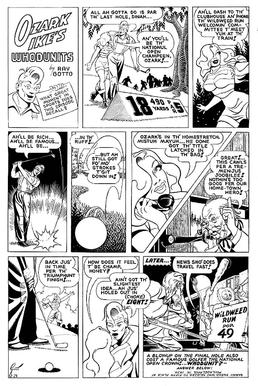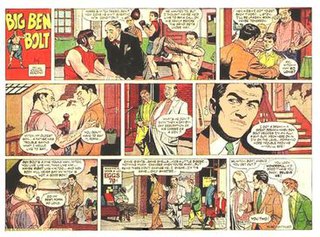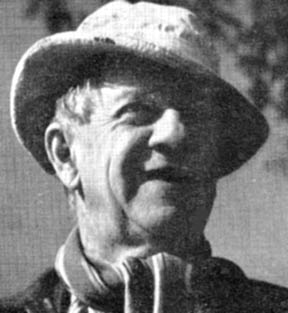
Ozark Ike is a newspaper comic strip about dumb but likable Ozark Ike McBatt, a youth from a rural area in the mountains. The strip was created by Rufus A. ("Ray") Gotto while he was serving in the Navy during World War II in Washington, D.C. as an illustrator for Navy instruction manuals. The strip ran from November 12, 1945, to September 14, 1958.

Murat Bernard "Chic" Young was an American cartoonist who created the comic strip Blondie. His 1919 William McKinley High School Yearbook cites his nickname as Chicken, source of his familiar pen name and signature. According to King Features Syndicate, Young had a daily readership of 52 million. Stan Drake, who drew Blondie in the 1980s and 1990s, stated that Young "has to go down in history as one of the geniuses of the industry."

They'll Do It Every Time is a single-panel newspaper comic strip, created by Jimmy Hatlo, which had a long run over eight decades, first appearing on February 5, 1929, and continuing until February 3, 2008. The title of the strip became a popular catchphrase.

King Features Syndicate, Inc. is an American content distribution and animation studio, consumer product licensing and print syndication company owned by Hearst Communications that distributes about 150 comic strips, newspaper columns, editorial cartoons, puzzles, and games to nearly 5,000 newspapers worldwide. King Features Syndicate also produces intellectual properties, develops new content and franchises, like The Cuphead Show!, which it produced with Netflix, and licenses its classic characters and properties.

Barney Google and Snuffy Smith, originally Take Barney Google, F'rinstance, is an American comic strip created by cartoonist Billy DeBeck. Since its debut on June 17, 1919, the strip has gained a large international readership, appearing in 900 newspapers in 21 countries. The initial appeal of the strip led to its adaptation to film, animation, popular song, and television. It added several terms and phrases to the English language and inspired the 1923 hit tune "Barney Google " with lyrics by Billy Rose, as well as the 1923 record "Come On, Spark Plug!"

Eugene Leslie Ahern was a cartoonist best known for his bombastic Major Hoople, a pompous character who appeared in the long-run syndicated gag panel Our Boarding House. Many of Ahern's comic strips took a surreal or screwball approach, notably The Squirrel Cage with its nonsensical catchphrase "Nov shmoz ka pop?"

A topper in comic strip parlance is a small secondary strip seen along with a larger Sunday strip. In the 1920s and 1930s, leading cartoonists were given full pages in the Sunday comics sections, allowing them to add smaller strips and single-panel cartoons to their page.
United Feature Syndicate, Inc. (UFS) is a large American editorial column and comic strip newspaper syndication service based in the United States and established in 1919. Originally part of E. W. Scripps Company, it was part of United Media from 1978 to 2011, and is now a division of Andrews McMeel Syndication. United Features has syndicated many notable comic strips, including Peanuts, Garfield, Li'l Abner, Dilbert, Nancy, and Marmaduke.

The Newspaper Enterprise Association (NEA) is an editorial column and comic strip newspaper syndication service based in the United States and established in 1902. The oldest syndicate still in operation, the NEA was originally a secondary news service to the Scripps Howard News Service; it later evolved into a general syndicate best known for syndicating the comic strips Alley Oop, Our Boarding House, Freckles and His Friends, The Born Loser, Frank and Ernest, and Captain Easy / Wash Tubbs; in addition to an annual Christmas comic strip. Along with United Feature Syndicate, the NEA was part of United Media from 1978 to 2011, and is now a division of Andrews McMeel Syndication. The NEA once selected college All-America teams, and presented awards in professional football and professional [NBA] basketball.

Jungle Jim is the fictional hero of a series of jungle adventures in various media. The series began on January 7, 1934, as an American newspaper comic strip chronicling the adventures of Asia-based hunter Jim Bradley, who was nicknamed Jungle Jim. The character also trekked through radio, film, comic book and television adaptations. Notable was a series of films and television episodes in which Johnny Weissmuller portrayed the safari-suit wearing character, after hanging up his Tarzan loincloth. The strip concluded on August 8, 1954.

Big Ben Bolt is a comic strip that was syndicated from February 20, 1950 to April 15, 1978. It was drawn by John Cullen Murphy, written by Elliot Caplin, and distributed by King Features Syndicate. The strip followed the adventures of boxer and journalist Ben Bolt.

Henry Boltinoff was an American cartoonist who worked for both comic strips and comic books. He was a prolific cartoonist and drew many of the humor and filler strips that appeared in National Periodical comics from the 1940s through the 1960s.

Boots and Her Buddies was an American comic strip by Edgar Martin that ran from 1924 to 1968, syndicated by the Newspaper Enterprise Association. Some newspapers presented the strip under the shortened title Boots. The character of Boots was variously labeled the "Sweetheart of the Comics", the "Sweetheart of America" and "Everybody's Sweetheart".

Little Jimmy, originally titled Jimmy, is a newspaper comic strip created by Jimmy Swinnerton. With a publication history from February 14, 1904, to April 27, 1958, it was one of the first continuing features and one of the longest running.

Our Boarding House is an American single-panel cartoon and comic strip created by Gene Ahern on October 3, 1921 and syndicated by Newspaper Enterprise Association. Set in a boarding house run by the sensible Mrs. Hoople, it drew humor from the interactions of her grandiose, tall-tale-telling husband, the self-styled Major Hoople, with the rooming-house denizens and his various friends and cronies.
This is a timeline of significant events in comics in the 1920s.

Barney Baxter in the Air is an American comic strip by Frank Miller. It started its run on September 30, 1935, for the Denver's Rocky Mountain News. Starting on December 7, 1936, it was syndicated by King Features. Barney Baxter was an "adventure strip" involving heroic exploits centering on aviation.

Clare Victor Dwiggins was an American cartoonist who signed his work Dwig. Dwiggins created a number of comic strips and single-panel cartoons for various American newspapers and newspaper syndicates from 1897 until 1945, including his best-known strip, the long-running School Days.
The Register and Tribune Syndicate was a syndication service based in Des Moines, Iowa, that operated from 1922 to 1986, when it was acquired by King Features to become the Cowles Syndicate affiliate. At its peak, the Register and Tribune Syndicate offered newspapers some 60 to 75 features, including editorial cartoonist Herblock, comic strips, and commentaries by David Horowitz, Stanley Karnow, and others.
Bela P. Zaboly, a.k.a. Bill Zaboly, was an American cartoonist best known for his work on Thimble Theatre with Popeye. Zaboly's illustrated signature used the initials BZ with the "B" formed by the wings of a bee. In headings for Thimble Theatre, his typeset credit line was given as Bill Zaboly rather than Bela Zaboly.


















